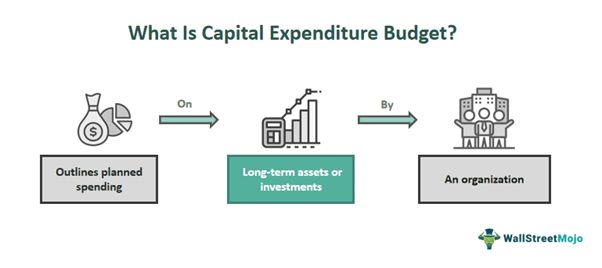Table of Contents
What Is Capital Expenditure (capex) Budget?
Capital expenditure (capex) budget refers to a formal budget that is a part of the annual budget of a firm describing the total sum and timings of purchase of fixed assets by it. The capital expenditure (capex) budget intends to arrange activities of expenditure of cash for buying fixed assets and long-term assets like new products plus markets and invest in future projects to allow it to grow profitably and healthily.

The capex budget method is used to approve allocating funds for buying particular items. It includes a financial assessment to determine if the firm's return on investment targets have been met, necessitating its review by the firm's management. Capex's budget contains a broad spectrum of expenditures like new facilities construction, new equipment for new staff, and upgrades of existing assets.
Key Takeaways
- A capital expenditure (capex) budget is an institutional budget that is a component of a company's yearly budget and details the overall amount and timing of the fixed asset purchases made by the company.
- It aims to organize cash-related spending on property and equipment, long-term assets, including new products and markets, as well as markets and investments in future projects to enable it to expand economically and healthily.
- By separating capital expenditure budgets from operational expenses, one must build a capex budget that takes into account the organization's capability for growth as well as the number of cash flows required to support expansion.
- Mainly owing to the capex budget, company management can reduce labor costs, expand the firm, and comply with regulations.
Capital Expenditure Budget Explained
A capital expenditure budget can be stated as a financial layout showing the total funds to be invested in various resources and projects by a business. Sometimes, the capex budget may last longer than the average duration of the annual budget. This happens because some firms may have a huge fixed asset to be acquired, requiring a long construction time and more than one year.
In some instances, businesses may undertake a series of significant building projects over time, spanning several years. While some projects may indeed last up to a decade, such extended durations are typically reserved for massive infrastructure developments or long-term strategic initiatives. Most firms aspire to enhance their competitiveness and expand their operations, necessitating the mobilization of funds, resources, and careful planning. These expansion or improvement endeavors are commonly accounted for within capital expenditure budgets. Furthermore, the capex budget serves as a critical tool for strategically allocating funds towards capital expenditures, aiming to enhance revenue generation and operational efficiency.
Furthermore, implementing a capex budget can be a strategic approach for businesses aiming to modernize their machinery or equipment and embark on significant operational modifications. Given the substantial scale of expenditure involved, effective management oversight becomes imperative in capex budgeting. Management must be equipped with both a forward-looking growth strategy and a clear understanding of the current financial landscape.
Through capex budgeting, management can chart a course for future growth spanning over a decade. Capex budgets empower management to achieve various objectives, including reducing labor costs, expanding business operations, ensuring compliance with regulatory requirements, enhancing product quality, and successfully formulating and executing capex investments.
How To Create?
The firm's management team analyses the investment return on every project proposal, in addition to the prerequisites of law and regulation. Plus, it also considers the influence of a proposal on the slowdown the company experiences before arriving together at a capital expenditure budget derived from an iterative procedure. The total number of fixed assets purchased would also change according to the degree of activity anticipated in the remainder of the budgeting.
All of these tasks must be completed before adapting to fit the organization's capacity for expansion and the necessary cash flows to fund growth. To achieve these goals, creating a capex budget is essential, as outlined below:
- The first step involves segregating expenditure budgets from operating expenditures.
- Following this, input from various departments is gathered to assess the firm's long-term benefits of capex and determine its economic feasibility within the current scenario.
- Executing the budget limit helps gauge the level of capital expenditure required.
- Evaluating returns on capital expenditure in terms of internal rate of return is crucial. The internal rate of return should always exceed the capex being considered.
Examples
Let us take a few examples to help you understand the topic.
Example #1
Chevron Corporation (NYSE: CVX) has outlined its capital expenditure (capex) plans for 2024, with an anticipated investment of approximately $15.5 to $16.5 billion for consolidated subsidiaries and around $3 billion for affiliate capex. The allocation includes significant spending in the upstream sector, with a focus on U.S. shale and tight portfolio development, as well as projects such as the Anchor project in the Gulf of Mexico. Additionally, Chevron plans to invest in lower carbon initiatives and expand into new energy business lines. Following recent acquisitions, including PDC Energy and the pending acquisition of Hess Corporation, Chevron's annual capex budget is expected to increase to between $19 and $22 billion, reflecting the company's commitment to both traditional and new energy sectors.
Example #2
Suppose ABC Manufacturing, a leading producer of electronic devices, is planning to expand its production capacity to meet increasing demand for its products. The management team recognizes the need to invest in new manufacturing equipment and facility upgrades to support this expansion. Here's how they create their capex budget:
The engineering, production, and finance departments at ABC Manufacturing collaborate to evaluate proposed capital projects. They assess factors such as potential return on investment (ROI), technological advancements offered by new equipment, and the impact on production efficiency. This analysis helps determine the long-term benefits of each project and assesses its economic feasibility within the current business context.
